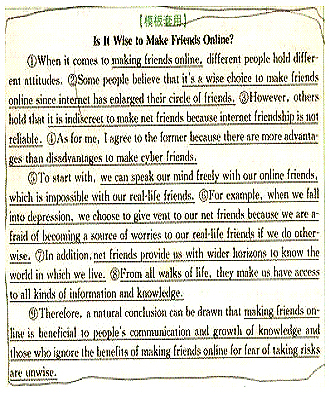| |
|
|
||
输入关键词,搜索本站更多内容 |
||

| 作者:广西大学行健文理学院/李晨辛 来源:本站征稿 本站编辑发布 | ||
| (←承前页) |
| It’s a typical pattern; what’s you need |
A typical sample of the “high-value” essay. |
|
 |
 |
|
General Teaching Method(“分步学习-总结指导教学法”简介):
I had been taught English writing during my freshman year under the process-product approach in the framework of the interactive “Cooperative Language Learning” (CLL). This is “an approach to teaching that makes maximum use of cooperative activities involving pair and small groups of learners in the classroom” (Richards, Rodgers, 2008, pp.192-203). Students were interested in learning in small groups involved 2 or 4 people rather than working alone (Xiao, 2005). Students were more active in a communicative class. The process-product approach is based on the need of a constant exchange of ideas and flow of information, especially on the background and writer’s original intention. In order to bring better communication between students, our teacher had heavily used “the interactive approach”, where the writer is “involved in a dialogue with his or her audience”. This approach holds that “the person primarily responsible for effective communication is the writer” (Johns, 1990). The teacher also used the social constructionist approach, in which “the written product is considered a social act that can take place only within and for a specific context and audience.” (Gabrielatos, 2002). The goal was to train us to express ideas precisely with particular examples which are helpful to enhance the effect of teaching.
The Process-Product Approach to Teaching English Writing(“分步学习-总结指导教学法” 在英语写作中的应用)
The emphasis was on the process of writing in all its stages—planning, brainstorming, collecting material, drafting and redrafting, proof-reading and error correction. students also created a final product in the form of a writing portfolio, collecting their writings together for others, not just the teacher, to read. The period of using the process-product approach of an essay was four weeks. In the 4 weeks, we should write an outline, 2 drafts of a 200-word essays, and a final draft which was cleanly and neatly printed out. In the first week, we brainstormed ideas and collected materials, and then put them into the outline. In the second week, our teacher would appoint students to present their outlines and the other students would put forwards their suggestions and corrections. We also exchanged our own outlines for revision and then wrote the draft 1. The next 2 weeks, the same steps repeated. During the class, the teacher would help us fine errors and give the extra requirements of writing.(I’ll talk about it later.) At the end of the period, our teacher checked over and assessed all the drafts. We’d gain both teacher’s and peers’ corrections. Our marks would be given depending on our overall assessment.
The process-product approach can be classified into a student-centered approach which should be used in language teaching. Students are learning together, communicating and discussing problems they found in each other’s essays. At the same time, they were invited to express their ideas on their need of learning language, and their performance shown motivation.
Extra Requirements/ Discursive Limits (写作禁令)
• Key-words limit is 5 in a 200 words essay.
• Do not start a sentence begin with AND, BUT, BECAUSE, SO. It’s colloquial.
• Use particular examples instead of SOME-words.
• Express directly in short sentences.
• Be careful of using CAN, COULD, SHOULD, MAY and pronouns.
• Do not change person. Such as personal pronouns “we” “I” “it”.
• Taboo phrases or sentences such as “every coin has 2 sides”, “…is good for people” , “good for economic” were forbidden
The Purpose of Discursive Limits (写作禁令的意义)
Extra requirements are writing techniques which force us to abandon the traditional writing style and “to break down the rhetorical practices and argumentative patters based on the overgeneralizing” (Igor Smerdov), which added diversity and variety to our essays and made them more readable. It is particular important when the teachers have to mark big numbers of essays becoming “composition slaves”. An English Writing teacher in China often becomes a “composition slave” (Hairston, M.,1986), reading, marking and correcting mistakes in hundreds of essays every month, teaching 12-18 hours a week with huge classes compared to Western countries. Some of these limits were quite strict; if we violate one of them, we would fail.
Problem at the beginning of using the process-product approach(“分步学习-总结指导教学法”在实践初的问题)
As we habituated to learn in the traditional method from primary school to high school, we had a hard time to getting used to the approach at the beginning. Almost all the students felt that the teacher was hypercritical, because many phrases which were considered good ones by Chinese teachers were banned in writing. Our thinking and writing styles had to change to fit the Western logic. For example, once I used a famous saying in my essay: ”Every coin has two sides”. It would absolutely up my grade if my teacher was a Chinese. However, my foreign teacher failed me.
My classmates were surprised at that time, because they all believed that the phrase was good and appropriate. So, it means that this was a common mistake in the whole class.
My classmates might use this saying in the future, but now, since I made a presentation in class and the teacher drew attention to this problem and failed me. This incident fully showed the advantages of the approach. And then, we got a new requirement not to use this sentence ”Every coin has two sides” ever in our essays! You write it and you fail.
From that time, I learned that what we think quite normal in Chinese thought may not be appropriate when we express ourselves in the right way in English. We could not learn those cultural things from the traditional approach because that is the way of one-side teaching----teachers are the authority. We had no discussion between the teacher and students or peers in classrooms,
(未完,接下页→)
| (本站2011年8月21日编辑发布) | |||
| 上一篇: | 原青岛市教科所所长/姜宏德教授:对双语教育学科定位问题的认识 | ||
| 下一篇: | (暂 无) | ||
|